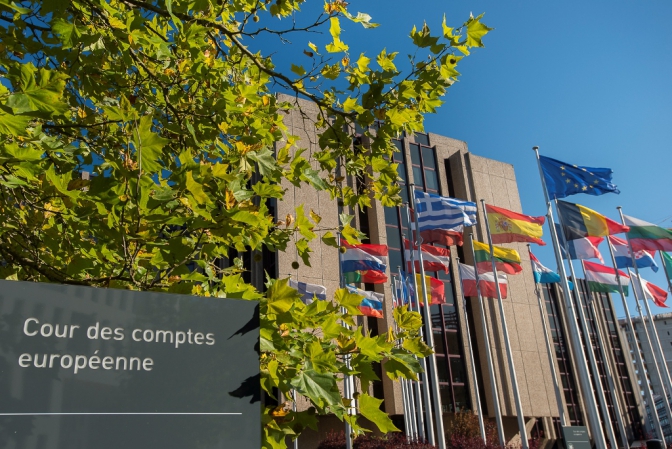EU’s legal framework for protecting intellectual property rights is not as effective as it could be according to a special audit report by the European Court of Auditors (ECA).
The scope of the audit was limited to EU trademarks, EU designs and EU geographical indications. According to ECA, patents were not included in the scope of because it was too early to audit this type of intellectual property rights (IPR).
In particular, the auditors assessed whether the EU Intellectual Property Office (EUIPO), located in Spain, is properly implementing the IPR regulatory framework for EU trademarks and EU designs. This included the methodology it uses for determining fees.
Overall, while the framework in place gives some guarantees, a number of shortcomings remain, in particular in the EU Designs Directive and the EU fees mechanism. The auditors also highlighted that EU and national systems would benefit from being better aligned.
Intellectual property rights are crucial to the EU’s global competitiveness. IPR-intensive industries generate almost half (45 %) of the EU’s economic activity, worth €6.6 trillion, and provide nearly a third (29 %) of total EU employment. Each year, counterfeit products are estimated to lead to €83 billion in lost sales in the legitimate economy.
If the problem of counterfeit products were tackled effectively, the EU economy would gain 400 000 jobs according to a recent estimate of EUIPO. Counterfeit products also have considerable safety risks, as was recently illustrated during the COVID-19 pandemic.
“Intellectual property rights are vital for the EU economy: they encourage innovation and investment, and discourage counterfeiting and its harmful effects”, said Ildikó Gáll-Pelcz, the Hungarian ECA Member responsible for the audit.
“But the current EU framework doesn’t give all intellectual property rights the protection they need. We hope that our recommendations will help the EU to increase that level of protection to the level that the single market requires.”
As it stands, the EU’s regulatory framework for designs is incomplete and outdated. As a result, national and EU systems are not aligned, allowing divergent practices between Member States during the application, examination, publication and registration processes, leading to legal uncertainty.
In addition, the auditors draw attention to the lack of an EU-wide protection regime for all products. The EU’s geographical indication framework does not concern non-agricultural products, such as crafts and industrial designs, although some Member States have legislation in place to protect them.
Self-financed agency
The main audit finding, however, concerns the role of EUIPO as a self-financed EU decentralised agency and its fee system. It does not reflect real costs, differs from the fees charged by national authorities and has resulted in accumulated surpluses over the years, amounting to over €300 million in EUIPO’s 2020 account.
This is not illegal but is contrary to the principle of a balanced budget, one of the criteria set by EU law. “We concluded that there is no clear methodology to determine EU fees,” the audit team told The Brussels Times.
It is up to the EUIPO to decide what to do with the surplus which until now has not been transferred to the EU budget.
A spokesperson of the Commission said it has taken note of the audit and remarked that the ECA found that the EUIPO framework was robust despite the observed shortcomings. In its formal reply to the audit, EUIPO rejected the auditors’ criticism and asserted that the fees are determined according to the rules.
“National fees structures fall within national financial sovereignty and there is therefore limited potential to converge,” according to EUIPO. “The size of the protection offered by an EU wide protection of trademarks in comparison with national protection justifies a higher level of fees.”
Another issue of contention is the governance model of the EUIPO which differs from other decentralised agencies that are subject to the European Parliament’s discharge procedure. As EUIPO is a fully self-financed agency, which is not imposing any burden to EU tax payers, its discharge is granted by the Parliament’s budgetary committee.
ECA is of the opinion that this is unsatisfactory and amounts to a conflict of interest as the majority of the members of the management board of EUIPO are MEPs in the budgetary committee. The Commission accepted ECAs' recommendation to assess the governance arrangements and methodology for determining fees.
What will happen to the surplus?
According to the replies, planned initiatives as well as new ones currently under discussion are expected to contribute to a decrease in the surplus in the coming years.
The EU Trade Mark Regulation provides mechanisms to prevent the accumulation of significant new surplus. New mechanisms such as the offsetting and the possible transfer of a substantive surplus to the EU budget should in principle prevent the accumulation of significant surplus. But this will apparently not happen in the near future.
According to the current rules, where a substantive surplus is generated over five consecutive years, the Budget Committee, upon a proposal from EUIPO… shall decide by a two-thirds majority on the transfer to the budget of the Union of a surplus generated from 23 March 2016. There has not been and there is currently no decision on a transfer since the conditions have not yet been met.
EUIPO plans to use part of the surplus to process new applications for geographical indications and trademarks free of charge but this will hardly reduce the surplus. An estimate on EU level shows that the registration and maintenance costs to oscillate around €17,000 per registration. With an expected number of around 30 registrations per year, this would only result in annual cost of half a million euro.
Furthermore, the Commission and EUIPO launched in January 2022 the new Small and Medium sized enterprises Intellectual Property Rights Fund (SME IP Fund). It will have a budget of € 47 million for the period of 2022-24. The EUIPO’s contribution will amount to €45 million from the surplus.
M. Apelblat
The Brussels Times

